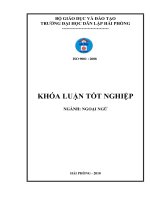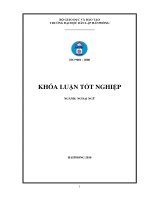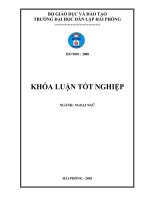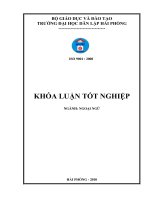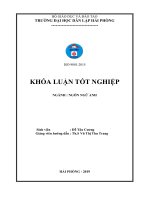A study on translation of English terms relating to hotel management into Vietnamese
Bạn đang xem bản rút gọn của tài liệu. Xem và tải ngay bản đầy đủ của tài liệu tại đây (1.33 MB, 51 trang )
BỘ GIÁO DỤC VÀ ĐÀO TẠO
TRƯỜNG ĐẠI HỌC DÂN LẬP HẢI PHÒNG
-------------------------------
ISO 9001:2015
KHÓA LUẬN TỐT NGHIỆP
NGÀNH: TIẾNG ANH
Sinh viên : Lê Thị Thanh Dương
Giảng viên hướng dẫn: ThS. Nguyễn Thị Quỳnh Chi
HẢI PHÒNG - 2018
BỘ GIÁO DỤC VÀ ĐÀO TẠO
TRƯỜNG ĐẠI HỌC DÂN LẬP HẢI PHÒNG
-----------------------------------
TÊN ĐỀ TÀI KHÓA LUẬN TỐT NGHIỆP
A STUDY ON TRANSLATION OF ENGLISH TERMS
RELATING TO HOTEL MANAGEMENT INTO VIETNAMESE
KHÓA LUẬN TỐT NGHIỆP ĐẠI HỌC HỆ CHÍNH QUY
NGÀNH: TIẾNG ANH
Sinh viên : Lê Thị Thanh Dương
Giảng viên hướng dẫn: ThS. Nguyễn Thị Quỳnh Chi
HẢI PHÒNG - 2018
BỘ GIÁO DỤC VÀ ĐÀO TẠO
TRƯỜNG ĐẠI HỌC DÂN LẬP HẢI PHÒNG
--------------------------------------
NHIỆM VỤ ĐỀ TÀI TỐT NGHIỆP
Sinh viên: Lê Thị Thanh Dương
Mã SV: 1412751051
Lớp: NA1801
Ngành: Tiếng Anh
Tên đề tài: A study on translation of English terms relating to hotel
management into Vietnamese
NHIỆM VỤ ĐỀ TÀI
1. Nội dung và các yêu cầu cần giải quyết trong nhiệm vụ đề tài tốt nghiệp
( về lý luận, thực tiễn, các số liệu cần tính toán và các bản vẽ).
……………………………………………………………………………..
……………………………………………………………………………..
……………………………………………………………………………..
……………………………………………………………………………..
……………………………………………………………………………..
……………………………………………………………………………..
……………………………………………………………………………..
……………………………………………………………………………..
2. Các số liệu cần thiết để thiết kế, tính toán.
……………………………………………………………………………..
……………………………………………………………………………..
……………………………………………………………………………..
……………………………………………………………………………..
……………………………………………………………………………..
……………………………………………………………………………..
……………………………………………………………………………..
……………………………………………………………………………..
……………………………………………………………………………..
3. Địa điểm thực tập tốt nghiệp.
……………………………………………………………………………..
……………………………………………………………………………..
……………………………………………………………………………..
CÁN BỘ HƯỚNG DẪN ĐỀ TÀI TỐT NGHIỆP
Người hướng dẫn thứ nhất:
Họ và tên:
Nguyễn Thị Quỳnh Chi
Học hàm, học vị:
Thạc sỹ
Cơ quan công tác:
Trường Đại Học Dân Lập Hải Phòng
Nội dung hướng dẫn: A study on translation of English terms relating to
Hotel Management into Vietnamese
Người hướng dẫn thứ hai:
Họ và tên:
Học hàm, học vị:
Cơ quan công tác:
Nội dung hướng dẫn:
Đề tài tốt nghiệp được giao ngày
tháng
năm
Yêu cầu phải hoàn thành xong trước ngày tháng
Đã nhận nhiệm vụ ĐTTN
năm
Đã giao nhiệm vụ ĐTTN
Sinh viên
Người hướng dẫn
Hải Phòng, ngày ...... tháng........năm 2018
Hiệu trưởng
GS.TS.NGƯT Trần Hữu Nghị
CỘNG HÒA XÃ HỘI CHỦ NGHĨA VIỆT NAM
Độc lập - Tự do - Hạnh phúc
PHIẾU NHẬN XÉT CỦA GIẢNG VIÊN HƯỚNG DẪN TỐT NGHIỆP
Họ và tên giảng viên:
...................................................................................................
Đơn vị công tác:
........................................................................ ..........................
Họ và tên sinh viên:
.......................................... Chuyên ngành: ...............................
Đề tài tốt nghiệp:
...................................................................................................
........................................................... ........................................
Nội dung hướng dẫn:
.......................................................... ........................................
....................................................................................................................................
1. Tinh thần thái độ của sinh viên trong quá trình làm đề tài tốt nghiệp
..............................................................................................................................................
..............................................................................................................................................
..............................................................................................................................................
..............................................................................................................................................
..............................................................................................................................................
..............................................................................................................................................
2. Đánh giá chất lượng của đồ án/khóa luận (so với nội dung yêu cầu đã đề ra trong
nhiệm vụ Đ.T. T.N trên các mặt lý luận, thực tiễn, tính toán số liệu…)
..............................................................................................................................................
..............................................................................................................................................
..............................................................................................................................................
..............................................................................................................................................
..............................................................................................................................................
..............................................................................................................................................
3. Ý kiến của giảng viên hướng dẫn tốt nghiệp
Được bảo vệ
Không được bảo vệ
Điểm hướng dẫn
Hải Phòng, ngày … tháng … năm ......
Giảng viên hướng dẫn
(Ký và ghi rõ họ tên)
QC20-B18
CỘNG HÒA XÃ HỘI CHỦ NGHĨA VIỆT NAM
Độc lập - Tự do - Hạnh phúc
PHIẾU NHẬN XÉT CỦA GIẢNG VIÊN CHẤM PHẢN BIỆN
Họ và tên giảng viên:
..............................................................................................
Đơn vị công tác:
........................................................................ .....................
Họ và tên sinh viên:
...................................... Chuyên ngành: ..............................
Đề tài tốt nghiệp:
......................................................................... ....................
............................................................................................................................ ........
....................................................................................................................................
1. Phần nhận xét của giáo viên chấm phản biện
..........................................................................................................................................
..........................................................................................................................................
..........................................................................................................................................
..........................................................................................................................................
..........................................................................................................................................
..........................................................................................................................................
..........................................................................................................................................
2. Những mặt còn hạn chế
..........................................................................................................................................
..........................................................................................................................................
..........................................................................................................................................
..........................................................................................................................................
..........................................................................................................................................
..........................................................................................................................................
..........................................................................................................................................
3. Ý kiến của giảng viên chấm phản biện
Được bảo vệ
Không được bảo vệ
Điểm phản biện
Hải Phòng, ngày … tháng … năm ......
Giảng viên chấm phản biện
(Ký và ghi rõ họ tên
QC20-B19
ACKNOWLEDGEMENT
During the time of completing this graduation paper, I have received a lot
of help, assistance, guidance, encouragement and contributed ideas from my
teachers, family and friends.
I wish, first of all, to express my deepest gratitude and indebtedness to my
supervisor – Ms. Nguyen Thi Quynh Chi, M.A- who has always been most
willing and ready to give me valuable advice, inspiration and supervision to
finish this study.
My sincere thanks are also sent to the teachers in the English Department
of Haiphong Private University for their useful lessons and whole-hearted
advice during four years studying here.
Last but not least, I would like to give my heartfelt thanks to my family
and my close friends, to whom I have never got enough words to express my
great gratitude for their encouragement and support.
This graduation paper is my sincere thanks to all of you.
Haiphong, August 1 st 2018
Le Thi Thanh Duong
i
LIST OF ACRONYMS:
SL
Source language
TL
Target language
ADJ
Adjective
ADV
Adverb
N
Noun
V
Verb
ESP
English for Specific Purpose
ST
Source Text
TT
Target Text
ELT
English Language Teaching
EAP
English for Academic Purpose
EBE
English for Business Economics
EOP
English for Occupational Purpose
ESBP
English for Specific Business Purpose
ESS
English for Social Study
EST
English for Science and Technology
ii
TABLE OF CONTENTS
ACKNOWLEDGEMENT .............................................................................. i
LIST OF ACRONYMS .............................................................................. …ii
PART ONE: INTRODUCTION ................................................................. 1
1. Rationale of the study ................................................................................. 1
2. Aims of the study ....................................................................................... 1
3. Scope of the study ...................................................................................... 2
4. Methods of the study .................................................................................. 2
5. Design of the study ..................................................................................... 2
PART TWO: DEVELOPMENT ................................................................. 4
Chapter I: Theoretical Background............................................................ 4
1. Translation Theory ..................................................................................... 4
1.1. Definition of translation .......................................................................... 4
1.2. Translation types ..................................................................................... 5
1.2.1 Word-for-word translation .................................................................... 6
1.2.2. Literal translation.................................................................................. 6
1.2.3. Faithful translation................................................................................ 6
1.2.4. Semantic translation ............................................................................. 7
1.2.5. Adaptation translation .......................................................................... 7
1.2.6. Free translation ..................................................................................... 8
1.2.7. Idiomatic translation ............................................................................. 8
1.2.8. Communicative translation ................................................................... 9
1.2.9. Other translation ................................................................................... 9
1.3. Types of equivalences ............................................................................. 9
2. ESP in translation ......................................................................................10
2.1. Definition of ESP ...................................................................................10
2.1.1. Absolute characteristics .......................................................................10
2.1.2. Variable characteristics ........................................................................10
2.2. Types of ESP ..........................................................................................11
3. Terms in English .......................................................................................12
3.1. Definition of a term ................................................................................12
3.2. The characteristics of terms ....................................................................13
3.3. Terms of Hotel Management ..................................................................13
Chapter II: A study on the translation of English terms relating to Hotel
Management into Vietnamese ...................................................................15
1. Overview of Hotel Management ................................................................15
1.1. Definition of Hotel Management .............................................................15
1.2 Some features of Hotel Management in Vietnam .....................................15
2. The popular construction of terms and strategies applied for translating
Hotel Management terms: ..............................................................................16
2.1. Single terms .............................................................................................16
2.2. Compound terms .....................................................................................16
2.3. Phrases.....................................................................................................18
2.4. Abbreviations ..........................................................................................19
3. Popular strategies and procedures applied in the translation of some
common Hotel Management terms into Vietnamese ......................................20
3.1. Procedures applied in the equivalence translation ...................................20
3.1.1. Literal translation..................................................................................20
3.1.2. Shift or transposition translation ...........................................................20
3.2.Popular strategies and procedures applied in non-equivalence translation22
3.2.1 Translation by paraphrasing unrelated words ........................................22
3.2.2 Translation by paraphrasing related words .......................................... 23
3.2.3.Translation by addition ..........................................................................24
3.2.4.Translation by using loan words ............................................................25
Chapter III: Finding and discussion ...........................................................27
1. Main finding ...............................................................................................27
2. Difficulties in translation of Hotel Management terms...............................28
3. Suggestions for translation of Hotel Management terms ............................28
PART III: CONCLUSION ..........................................................................30
1. Summary of the study.................................................................................30
2. Implications for further study .....................................................................30
REFERENCES .............................................................................................32
APPENDIX 1 ................................................................................................34
APPENDIX 2 ................................................................................................38
PART ONE: INTRODUCTION
1.
Rationale of the study:
Hotel Management is a field of the hospitality industry that provides the
necessary services for customers to relax and entertain in a comfortable and safe
way. These essential services can include a number of aspects such as moving,
accommodation, dining, sightseeing, etc. It plays an important role in the
economy of each nation.
Vietnam is rising in its popularity as a tourist destination in South East
Asia. Therefore, the hospitality industry requires the high quality of human
resources mastering both skill and knowledge. Knowing basic hotel
management terms not only give people a range of career opportunities but also
becomes a useful tool when they travel all around the world.
This motivates me – a student of Haiphong Private University who has
approached the modern education and some new training programs of my
university, therefore, I have been attracted by the programs and its terms. I find
it is a challenging field and should understand terms in Hotel Management.
Because it is very practical and necessary not only for me but also for my
friends, my family and everybody, who have great demand in traveling inbound
as well as outbound. For these reasons, I have chosen “A study on translation of
English terms relating to Hotel Management into Vietnamese” for my
graduation paper.
2.
Aims of the study
The study on translation of education terms aims to figure out an
overview on translation strategies and procedures commonly employed in
translation of Hotel Management terms.
In details, my Graduation Paper aims at:
Collecting and presenting basic English terms in Hotel Management terms.
Providing their Vietnamese equivalents or expressions
1
Analyzing translation strategies and procedures employed in the translation
of these English terms into Vietnamese.
Providing students majoring in the subject and those who may concern
a draft and short reference of basic English terms in Hotel Management.
I hope that this study can provide readers with overall comprehension
about the information from written text and from visual forms of presentation
relating to Hotel Management terms, help them translate it effectively.
3.
Scope of the study:
Hotel Management field is an extremely large field. Due to the limitation
of time, knowledge and experience, I am not ambitious to study all matters of
this theme but only focus on translation theory and translation strategies of some
major Hotel Management terms in Vietnamese
4.
Methods of the study:
Being a student of Foreign Language Department, after years of learning
English, studying translation, I was equipped with many skills or techniques for
translation. This graduation paper is carried out with a view to help learners
enlarge their lexical resource and have general understanding about translation
and translation of Hotel Management terms. To successfully complete this topic,
I am patient and enthusiastic:
To consult my supervisor and my friends.
To search documents and the sources of information from the internet,
TV, reference books, newspapers, journals etc.
To base on my experiences on hotel management.
5.
Design of the study:
My graduation paper is divided into three parts :
The first part is the Introduction, including: the rationale, aims, scope, method
and design of the study.
2
The second part is the Development with three chapters:
Chapter I: Theoretical background: It focuses on the concepts of
translation, terms in English and form of language as well as different
methods used by professional translators.
Chapter II: A study on the translation of English terms relating to Hotel
Management into Vietnamese, including the popular construction of terms
and some strategies applied in translation of some common Hotel
Management terms
Chapter III: Finding and Discussion
The last part is the Conclusion in which I summary the study (experiences
acquired and state the implications for future study).
3
PART TWO: DEVELOPMENT
CHAPTER I
THEORETICAL BACKGROUND
1. Translation Theory
1.1. Definition of translation
There are many concepts of translation all over the world. Following are some
typical concepts:
Translation is the interpreting of the meaning of a text and the
subsequent production of an equivalent text, likewise called a
"translation", that the text to be translated is called the "source text," and
the language that it is to be translated into is called the "target language"
(TL); the final product is sometimes called the "target text"
communicates the same message in another language.
( Wikipedia )
Translation is the process of changing something that is written or
spoken into another language.
( Advanced Oxford Dictionary )
Translation is the replacement of text material of this language (source
language) with text material of another (target language).
( Catford,1965:20 )
Translation is a transfer process, which aims at the transformation of a
written source language (SL) text into an optimally equivalent target
language (TL) text, and which requires the syntactic, the semantic and the
pragmatic understanding and analytical processing of the SL.
( Wilss,1982:3 )
Translation consists of reproducing in the receptor language the closest
natural equivalent of the source language message, first in terms of
meaning and secondly in terms of style.
( Nida, 1982:83 )
4
Translation involves the transfer of meaning from a text in one language
into a text in another language.
( Bell, 1991: 8 )
Translation is a process of communication whose objective is to import
the knowledge of the original to the foreign reader.
( Levy, 1967:148 )
Translation is to be understood as the process whereby a message
expressed in a specific source language is linguistically transformed in
order to be understood by readers of the target language"
( Houbert, 1998:1 )
Translation is an act of communication which attempts to relay, across
cultural and linguistic boundaries, another act of communication.
( Hatim and Mason, 1997:1 )
Translation is the act of transferring through which the content of a text
is transferred from the source language into the target language.
( Foster, 1958:1)
Translation is a text with qualities of equivalence to a prior text in
another language, such that the new text is taken as a substitute for the
original.
( David Frank, Wordpress.com)
1.2. Translation types
There is a considerable variation in the types of translations produced by
translators. Some works are only in two languages and competent in both. Other
works are from their first language to their second language, and still others
from their second language to their first language. Depending on these matters
of language proficiency, the procedures used will vary from projects to projects.
In most projects in which SL is involved, a translation team carries on the
project. Team roles are worked out according to the individual skills of team
members. There is also some variation depending on the purpose of a given
translation and the type of translation that will be accepted by the intended
5
audiences. According to Peter New mark, there are 8 methods of translation on
which a professional translator can rely.
1.2.1. Word-for-word translation
In this kind of translation, TL is often right below the SL words. The SL
word-order is preserved as precisely as possible and the words are translated
word-by-word by their most common meanings regardless of the context.
Culture words are translated literally. The main use of word-for-word translation
is either to understand the structures of the SL or to analyze a difficult and
complex text as a pre-translation process.
ST: She plays piano very well
TT: Chị ấy chơi piano rất hay.
ST: The party A will incur liability for the victims.
TT: Bên A sẽ chịu trách nhiệm pháp lý đối với các nạn nhân
1.2.2. Literal translation
The SL grammatical constructions are converted to their nearest TL
equivalents but the lexical words are again translated singly, out of context. As a
pre-translation process, this indicates the problems to be solved. An interlinear
translation is a completely literal translation. For some purposes, it is desirable
to reproduce the linguistic features of the source text. Although these literal
translations may be very useful for purposes related to the study of the source
language, they are of little help to speakers of the receptor language who are
interested in the meaning of the source language text. A literal translation
sounds like nonsense and has little communication value. For example:
ST: I tried for a moment to see the situation through her eyes
TT: Tôi đã thử một lần cố nhìn nhận tình huống theo cách nhìn của cô ta
ST: Invite friend about house me play
TT:. Mời bạn về nhà tôi chơi.
1.2.3. Faithful translation
6
The translation reproduces the exact contextual meaning of the original
within the constraints of the grammatical structures of the target language. It
transfers cultural words and preserves the degree of grammatical and lexical
deviation from SL norms. It attempts to be completely faithful to the intentions
and the text-reality of the SL writer.
ST: Today the Vietnamese are, almost no exception, extremely friendly to
Western visitors.
TT: Ngày nay, người Việt Nam, gần như không có ngoại lệ, đều rất thân thiện
với du khách phương Tây.
1.2.4. Semantic translation
It differs from faithful translation only in as far as it must take more
account of the aesthetic value of the SL text, compromising on meaning where
appropriate so that no assonance, word play or repetition jars in the finished
version. It does no rely on cultural equivalence and makes very small concession
to the readership. While faithful translation is dogmatic, semantic translation is
more flexible.
“…Semantic translating where the translator attempts, within the base syntatic
and semantic constraints of the TL, to reproduce the precise contextual meaning
of the author” – Newmark (1982:22)
ST: Today the Vietnamese are, almost no exception, extremely friendly to
Western visitors
TT: Ngày nay người Việt Nam đếu rất thân thiện với các khách du lich nước
ngoài.
ST: We hope you will enjoy your staying with us
TT: Chúng tôi hy vọng ngài sẽ có một kì nghỉ tuyệt vời tại khách sạn này.
1.2.5. Adaptation translation
This is the “freest” form of translation. It is used mainly for plays and
poetry; the themes, characters, plots are usually preserved , the SL culture
converted to the TL culture and the text rewrite.
7
“Adaptation has a property of lending the ideals of the original to create a new
text used by a new language more than to be faithful to the original. The creating
in adaptation is completed objective in content as well as form” - Dung Vu
(2004). For example:
ST:
It would rather the victorious brightness
In an only moment the centenary twinkle
TT: Thà một phút huy hoàng rồi vụt tắt
Còn hơn buồn le lói suốt trăm năm
( Xuân Diệu )
ST: We would like to inform you that the construction of the project is
temporarily delayed due to bad weather.
TT: Chúng tôi muốn thông báo với các ngài rằng do điều kiện thời tiết không
thuận lợi nên việc thi công dự án tạm thời dừng lại.
1.2.6. Free translation
The translation is not close to the original, but the translator just transmits
meanings of the SL in his own words. It reproduces the matter without the
manner, or the content without the form of the original. Usually it is paraphrase
much longer than the original. Therefore, the text in TL sounds more natural. On
the contrary, translating is too casual to understand the original because of its
freedom. For example:
ST: That guy is as poor as a church mouse
TT: Anh ta nghèo rớt mồng tơi.
1.2.7. Idiomatic translation
Idiomatic translation reproduces the “message” of the original but tends to
distort nuances of meaning by preferring colloquialisms and the idiom where
these do not exists in the original. For example:
ST: Man proposes, God disposes
TT: Mưu sự tại nhân, hành sự tại thiên
8
ST: Better late than never
Diamond cuts diamond
TT: Thà muộn còn hơn không
Vỏ quýt dày có móng tay nhọn
1.2.8. Communicative translation
It attempts to render the exact contextual meaning of the original in such a
way that both language and content are readily acceptable and comprehensible
to readership.
“… But even here the translation still has to respect and work on the form of the
source language text as the only material basic for his work” - Peter
Newark,(1982:39)
ST: Good morning!
TT: Bác đi đâu đấy ạ!
1.2.9. Other translation
Beside the above common the types of translation, some of the following
types are sometime used during translation process. They include: service
translation, plum prose translation, information translation, cognitive translation,
academic translation.
1.3. Types of equivalence
Based on Nida’s theory, equivalents are divided into two kinds: formal
equivalent and dynamic equivalent. Formal equivalent focuses attention on the
message in form. The message in the receptor language should match as closely
as possible the different element in the source language.
Dynamic equivalent, or function equivalent follows the principle of
equivalent effect, that is, the relationship between the receptor and the message
should aim at being the same as that between the original receptor and the
source language message. It attempts to render receptor’s words from one
language to another, and caters to the receptor’s linguistic competence and
cultural needs.
9
According to Koller (1979), there are five types of equivalents:
Denotative equivalent: the SL and the TL words refer to the same thing in
the real world. It is an equivalent of the extra linguistic content of a text.
Connotative equivalent: This type of equivalent provides additional value
and is achieved by the translator’s choice of synonymous words or expression.
Text-normative equivalent: the SL and the TL words are used in the same
or similar context in their respective languages.
Pragmatic equivalent: With readership orientation, the SL and TL text
have the same effect on their respective readers.
Formal equivalent: This type of equivalence produces an analogy of form
in the translation by either exploiting formal possibilities of the TL, or creating
new forms in TL.
Although equivalence translation is defined with different point of view of
theorists, it is the same effective equivalence between SL and TL.
2.
ESP in translation
2.1. D efinition of ESP
ESP is the abbreviation for English for Specific Purpose. It is defined in
the other ways. Some people described ESP as simply being the teaching of
English for any purpose that could be specified. Others, however, were more
precise, describing it as the teaching of English used in academic studies or the
teaching of English for vocational or professional purposes.
Jony Dudley- Evans, co-editor of the ESP Joural gives an extended definition of
ESP in terms of “absolute” and “variable” characteristic.
Definition of ESP (Dudley-Evans, 1997)
2.1.1. Absolute characteristics
ESP is defined to meet specific needs of the learners.
ESP makes use of underlying methodology and activities of the discipline
it serves.
ESP is centered on the language appropriate to these activities in terms
of grammar, lexis, register, study skills, discourse and genre.
2.1.2. Variable characteristics
ESP may be related to or designed for specific disciplines.
10
ESP may use in specific teaching situations, a different methodology from
that of General English.
ESP is likely to be designed for adult learners, either at a tertiary level
institution or in a professional work situation. It could, however, be for
learners at secondary school level.
ESP is generally designed for intermediate or advanced students.
Most ESP courses assume some basic knowledge of the language
systems.
2.2. Types of ESP
David Cater (1983) identifies three types of ESP:
English as a restricted language
English for Academic and Occupational Purpose
English with specific topic
The language used by air traffic controllers or by waiters are examples of
English a restricted language. Mackay and Mountford (1978) clearly illustrate
the difference between restricted language and language with this statement:
“… The language of international air-traffic control could be regarded as
“special”, in the sense that the repertoire required by the controller is strictly
limited and can be accurately determined in situation, as might be the linguistic
needs of a dining-room waiter or air-hostess. However, such restricted
repertoires are not languages, just as a tourist phrase book is not grammar.
Knowing a restricted “language” would not allow the speaker to communicate
effectively in novel situation or in contexts outside the vocational environment”
(p.4-5)
The second type of ESP identified by Carter (1983) is English for
Academic and Occupational purposes. In the “Tree of ESP” (Hutchinson and
Waters, 1987), ESP is broken down into three branches:
English for Science and Technology (EST)
English for Business and Economics (EBE)
English for Social Studies (ESS)
11
Each of these subject areas is further divided into two branches:
English for Academic purpose (EAP)
English for Occupational purpose (EOP).
An example of EOP for the EST branch is “English for Technicians”
whereas an example of EAP for the EST branch is English for Medical Studies.
Hutchinson and Waters (1987) note that there is not a clear-cut distinction
between EAP and EOP: “People can work and study simultaneously; it is also
likely that in many cases the language learnt for immediate use in a study
environment will be used later when the student takes up, or returns to a job”
(p.16). Perhaps this explains Carter’s rationale for categorizing EAP and EOP
under the same type of ESP. It appears that Carter is implying that the end
purposes of both EAP and EOP are one in the same: employment. However,
despite the end purpose being identical, the means taken to achieve the end is
very different indeed. It contends that EAP and EOP are different in terms of
focusing on Commins (1979) notion of cognitive academic proficiency versus
basic interpersonal skills. This is examined in further details below.
The third and final type of ESP identified by Carter (1983) in English
with specific topics, Carter notes that it is only here where emphasis shifts from
purposes to topics. This type of ESP is uniquely concerned with anticipated
future English need of, for example, scientists requiring English for post
graduate reading studies, attending conferences or working in foreign
institutions. However, I argue that this is not a separate type of ESP. Rather it is
an integral component of ESP courses or programs which focus on situational
language. This situational language has been determined based on the
interpretation of results from need analysis of authentic language used in target
workplace setting.
3. Terms in English:
3.1. Definition of a term
A term is a word or expression that has a particular meaning or is used in
particular activity, job, profession, etc…
(Longman Dictionary of Contemporary English, 1991)
12
Term is a variation of language in a specific condition (Peter Newmark) and
he stated that the central difficulty in translation is usually the new
terminology. Even then, the main problem is likely to be that of some terms
in the source text which are relatively content-free, and appear only once. If
they are context-bound, you are more likely to understand them by gradually
eliminating the less likely versions.
3.2. The characteristics of terms:
There is distinction between technical and descriptive terms. The original
source language writer may use a descriptive term for a technical object for
three reasons:
The objective is new and not yet has a name.
The descriptive term is being used as a familiar alternative, to avoid
repetition.
The descriptive term is being used to make a contrast with another one.
Normally, you should translate technical and descriptive terms by their
counterparts and, in particular, resist the temptation of translating a descriptive
by a technical term for showing off your knowledge, there by sacrificing the
linguistic force of the SL descriptive term. However, if the SL descriptive term
is being used either because of the SL writer’s ignorance or negligence, or
because the appropriate technical term does not exist in the SL, and in particular
if an object strange to the SL but not to the TL culture is being referred to, then
you are justified in translating a descriptive by a technical term.
Terminology makes up perhaps 5-10 % of a text. The rest is “language”
usually a natural style of language; and there you normally find an authoritative
text aspires to such a style; if it does not, you gently convert it to natural and
elegant language-the write will be grateful to you.
3.3. Terms of Hotel Management:
According to structure, Hotel Management Terms consist of following
types:
Single terms are those that consist of just one word, example:
Commissions, Confirmation, Tariff, etc.
13
